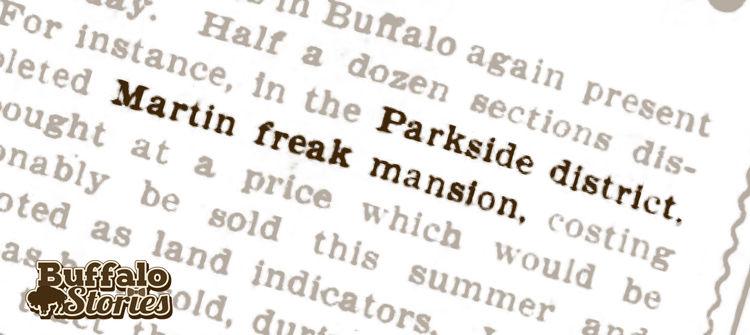This article originally appeared in The Buffalo News on February 17, 2017.
Tens of millions of dollars into a decade-long renovation, Frank Lloyd Wright’s Darwin Martin House is among the crown jewels in Buffalo’s resurgence in architectural tourism.
Wright called the home his “opus” and considered it one of his great designs, but as it was being built in 1905, not everyone in Buffalo felt that way. Those feelings were reflected in the pages of The Buffalo Courier, which referred to the place as the “Martin freak mansion” in one story and then as “the freak house of the twentieth century” in another.
The text of an article about the Martin House from the Courier’s Real Estate page.
The freak house of the twentieth century on this continent is now being built at Jewett and Summit avenues, Parkside. It will be built entirely of angles. Except for two arched fireplaces, there will not be a curve anywhere, from the walls that form the shell of the house to the spindles that help form the banisters of the stairways.
But in this house of successively multiplying series of sharp angles will be about as comfortable a home as can be made on earth. It will be lighted by its own electric plant. It will be heated by its own hot water plant. All the water supply will be filtered. The hot water supply will always run hot immediately because it will be “on circulation.” A passage 10 feet long underneath a pergola will connect the house with the stable. The passage will also be utilized as a bowling alley.
It may prove to be a house of puzzles to the undiscerning visitor. No steps will be seen by the coming guest, although there will be two sets in the front portion of the house, to say nothing of two more sets leading to a broad veranda. And when the guest gets inside the house he’ll have a hard time finding a way to the second story. There will be one stairway for the use of the family and its guests. But it will start unobtrusively from a spot that has 33 reproductions. So there will be only one chance in 34 of finding the stairway. As the architect expresses it, “we mortify our staircases”— they are a means to an end and never a feature.
The owner of this house is Darwin D. Martin. The architect is Frank Lloyd Wright of Chicago. He is trying to found a simple style of American architecture.
The house is being built on a lot having 200 feet on Jewett Avenue and 300 feet on Summit Avenue. It faces on Jewett. The house will be 155 feet wide, while its deepest dimension will be 88 feet. It will be only 30 feet high. It will have a deep basement and two stories. Above the base of white concrete the walls are of brick faced with slender Roman vitreous brick running in this from tan to orange. The face brick is laid with half-inch sunken joints, thus serving to bring the beauty of the coloring into greater relief “like corded silk.” These walls will run up to a low hover hip roof of red tile with cornices 5 1/2 feet beyond the face of the building. The outline of the building will be broken up by many angles, always perfectly balanced by angles on the other side.
A broad veranda on the east side of the house is balanced by a large porte cochere on the west side. The projection from the front wall of the building made by the extension of the library is balanced by a similar projection of the dining room from the rear wall.
A pergola 80 feet long and 10 feet wide will connect the house with a conservatory in the rear lot. This building is 18 feet wide by 60 feet and 15 feet high. To the left or west of the conservatory is the stable, which is practically finished. Both conservatory and stable are faced with the Roman brick and contain series of balanced angles of their own. All the buildings will be fireproof.
The outside steps of the house will be concealed by piers of the face brick topped by concrete coping on which will be placed stone vases four feet across. Although the top of the basement windows will be three feet above the level of the ground they, too, will be hidden. A series of terraces will effectually bar them from outside observation. Yet they will shed a profusion of light into that section of the building.
The house and its connected buildings will have an artistic setting.
The interior of the house will have a simple elegance more costly than ornate embellishments and will be carried out on the same principles as the exterior. The cost of the building is estimated at $150,000.










